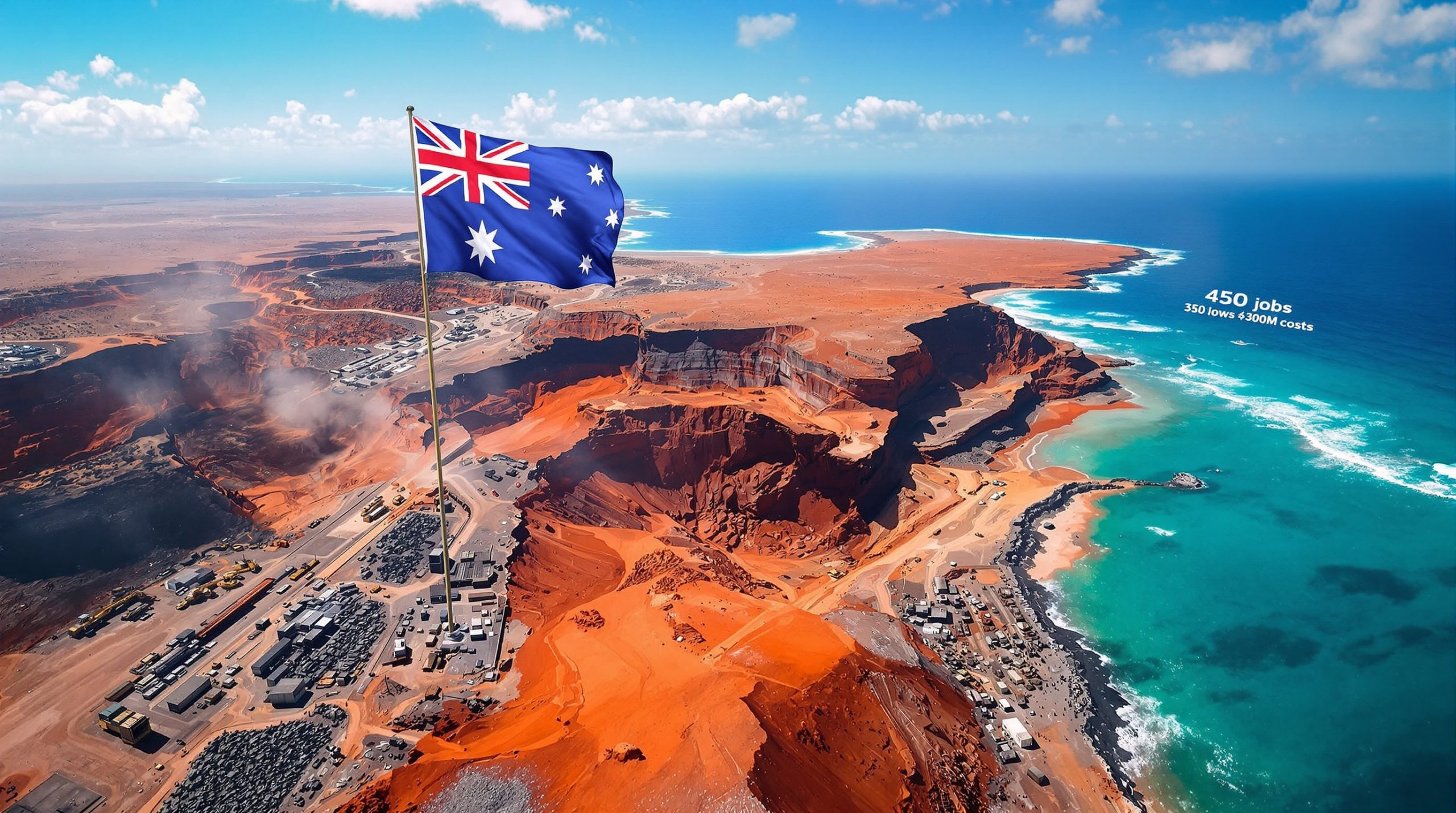Trump Reopens Alaska's Arctic Refuge to Oil and Gas Drilling: A Seismic Shift in U.S. Energy Policy
The decision to reopen Alaska's Arctic National Wildlife Refuge (ANWR) to oil and gas exploration marks a fundamental transformation in American energy strategy. This policy reversal, known as Trump reopens Alaska's Arctic Refuge to oil and gas drilling, affects roughly 1.56 million acres of protected wilderness that geologists believe could contain substantial petroleum reserves, fundamentally reshaping the nation's energy independence trajectory and global market positioning.
The implications extend far beyond Alaska's borders. Energy analysts suggest this move could significantly alter North America's oil production capacity whilst simultaneously reigniting debates over environmental stewardship and indigenous rights. The region's potential represents one of the continent's last major untapped conventional oil reserves, making it a strategic asset in America's energy security portfolio.
Current market conditions add urgency to this development. With WTI crude trading at $61.79 and experiencing notable volatility, the prospect of additional domestic production capacity has captured industry attention. However, oil price movements could significantly influence project economics. Furthermore, the path from policy announcement to actual production involves numerous complex hurdles that could delay meaningful output for years.
Historical Context: The Political Pendulum of ANWR Development
How Did We Get Here? A Timeline of Policy Reversals
The Arctic Refuge has experienced dramatic policy swings reflecting broader shifts in American political priorities. The Tax Cuts and Jobs Act of 2017 initially opened these lands to energy development, representing a significant victory for domestic drilling advocates. This legislative breakthrough came after decades of environmental protection that had kept the region off-limits to industrial activity.
The Biden administration's subsequent suspension of drilling activities in 2021 demonstrated how energy policy can become a political football, with each administration reversing predecessor decisions. These rapid policy changes create uncertainty for energy companies trying to plan long-term investments in Arctic infrastructure and development.
Industry observers note that such regulatory volatility complicates project economics. Companies must factor political risk into their investment calculations, often requiring higher returns to justify Arctic ventures given the possibility of future policy reversals.
The Economic Stakes Behind the Political Drama
The U.S. Geological Survey estimates suggest ANWR's coastal plain contains between 4.3 and 11.8 billion barrels of technically recoverable oil. At current market prices around $62 per barrel, this resource base represents a potential value exceeding $400 billion, though actual recovery costs and market price fluctuations could significantly alter these calculations.
These reserves could fundamentally reshape Alaska's economic landscape. The state's petroleum sector has struggled with declining production from aging North Slope fields, dropping from peak output levels of over 2 million barrels per day in the 1980s to approximately 450,000 barrels per day currently. ANWR development could potentially double Alaska's current production capacity.
The economic multiplier effects extend throughout Alaska's economy. Petroleum revenues fund substantial portions of state government operations and provide dividend payments to residents. Revitalising the sector through Trump reopens Alaska's Arctic Refuge to oil and gas drilling could restore Alaska's fiscal stability whilst reducing dependence on federal transfers.
What Are the Immediate Market Implications?
Oil Price Volatility and Supply Chain Considerations
Market reactions to the ANWR announcement reflect complex dynamics between short-term speculation and long-term supply fundamentals. Whilst WTI crude has shown increased volatility, with recent gains of +5.62%, traders recognise that actual production remains years away, requiring extensive permitting, environmental reviews, and infrastructure construction.
The timeline to first oil production presents significant challenges. Industry experts estimate 7-10 years minimum before meaningful production could begin, assuming regulatory approvals proceed without major delays. This extended development timeline means ANWR's impact on current market conditions remains largely psychological rather than physical.
Infrastructure requirements represent massive capital commitments. Estimates suggest $15-20 billion in pipeline and facility investments would be necessary to support full-scale development. These costs must be recovered through oil sales over decades, making project economics sensitive to long-term price assumptions.
Production potential at peak development could reach 600,000 to 1.2 million barrels per day, representing substantial additional supply that could influence global market dynamics. However, achieving these production levels depends on successful exploration, favourable geology, and sustained political support throughout the development cycle.
Impact on Alaska's Energy Economy
Alaska's petroleum industry faces an aging infrastructure challenge that ANWR development could help address. The Trans-Alaska Pipeline System (TAPS) currently operates well below its design capacity of 2.1 million barrels per day. Additional throughput from ANWR could improve pipeline economics and extend the system's operational viability.
Regional economic benefits could extend beyond direct petroleum revenues. Construction and operational phases would create substantial employment opportunities in engineering, construction, logistics, and support services. These economic impacts could revitalise Alaska's North Slope region and provide skilled employment for thousands of workers.
Tax revenue implications for Alaska are substantial. The state's petroleum revenue system captures significant portions of production value through property taxes, production taxes, and corporate income taxes. Peak ANWR production could generate $8-12 billion annually in state revenues, though these projections depend heavily on oil price assumptions and production rates.
Which Companies Stand to Benefit Most?
Major Players Positioning for Arctic Development
Several established energy companies possess the technical expertise and financial resources necessary for Arctic development. ConocoPhillips emerges as a primary beneficiary given its extensive North Slope operations and adjacent Prudhoe Bay assets. The company's existing infrastructure and regulatory relationships position it advantageously for ANWR participation.
BP's historical Alaska presence and Arctic drilling capabilities make it another likely participant. The company's experience with extreme weather operations and environmental compliance in sensitive areas could prove valuable for ANWR development. However, BP's recent strategic focus on renewable energy transformations may influence its participation level.
ExxonMobil's technical capabilities and global project management experience suit the complex requirements of Arctic development. The company's financial resources and integrated business model could support the long-term commitments necessary for successful ANWR projects.
Hilcorp, as an aggressive independent operator with significant Alaska focus, might pursue ANWR opportunities through partnerships or joint ventures. The company's operational expertise in mature fields and cost-effective development approaches could complement major operator capabilities.
Investment Requirements and Risk Assessment
Arctic drilling demands specialised technology and substantial risk management capabilities. Companies must evaluate extreme weather conditions, environmental compliance costs, and potential legal challenges when assessing project viability. The harsh Arctic environment requires specialised equipment, extensive safety protocols, and redundant systems to ensure operational continuity.
Environmental liability represents a significant risk factor. Companies operating in ANWR would face strict environmental regulations and potential cleanup costs from any incidents. This liability exposure requires comprehensive insurance coverage and robust environmental management systems.
Market risk considerations include oil price volatility, production uncertainty, and political risk. Companies must model various scenarios to determine acceptable returns given the substantial upfront investments and extended payback periods characteristic of Arctic projects.
Environmental and Indigenous Rights Considerations
What Are the Ecological Concerns?
The Arctic Refuge serves critical ecological functions that industrial development could disrupt. The Porcupine caribou herd, numbering approximately 218,000 animals, depends on the coastal plain for calving grounds during summer months. Any industrial activity could potentially alter migration patterns and affect herd reproduction rates.
Polar bear populations utilise sea ice habitat adjacent to ANWR for hunting and denning. Climate change already stresses these populations through reduced ice extent, and additional industrial activity could compound these pressures. The U.S. Fish and Wildlife Service must evaluate cumulative impacts on threatened species under the Endangered Species Act.
Bird migration routes cross the Arctic Refuge during spring and fall seasons, with millions of waterfowl and shorebirds relying on coastal wetlands for feeding and rest. Oil and gas infrastructure could fragment habitats and create collision hazards for migrating species.
Environmental groups argue that Arctic ecosystems' sensitivity to disturbance makes industrial development particularly risky. The region's slow recovery rates from environmental damage mean that impacts could persist for decades or centuries, as highlighted by recent analysis of Trump's Arctic drilling decisions.
Indigenous Community Perspectives
The Gwich'in Nation maintains strong opposition to ANWR development based on subsistence lifestyle dependencies on caribou migration patterns. Tribal representatives argue that industrial development threatens their cultural survival by potentially disrupting traditional hunting and food sources that have sustained their communities for generations.
Some Inupiat communities express support for ANWR development due to potential economic opportunities. These communities emphasise employment prospects, tax revenues, and infrastructure improvements that could benefit their members. However, opinions vary among different Inupiat organisations and communities.
This divide highlights complex social dimensions of Arctic energy development. Federal consultation requirements mandate government-to-government discussions with affected tribes, though disagreements among indigenous groups complicate policy development.
Legal challenges based on indigenous rights claims could delay or complicate ANWR development. Courts have increasingly recognised tribal sovereignty and treaty rights, potentially affecting project permitting and operational requirements.
How Does This Affect Global Energy Security?
Reducing Import Dependencies
American petroleum imports currently average approximately 6.3 million barrels per day, representing significant exposure to international supply disruptions and price volatility. ANWR production could reduce this import dependence by providing additional domestic supply sources under American regulatory control.
Enhanced energy security benefits extend beyond oil markets. Reduced import dependence strengthens America's geopolitical position by decreasing vulnerability to supply embargoes or market manipulation by hostile nations. This strategic autonomy becomes particularly valuable during international crises or trade disputes that affect U.S. economy & tariffs.
Domestic production also generates economic benefits through job creation, tax revenues, and trade balance improvements. Money spent on imported oil represents economic value flowing overseas, whilst domestic production captures these benefits within the American economy.
The strategic petroleum reserve could benefit from additional domestic production capacity. Having readily available domestic sources reduces the need for emergency reserve releases during supply disruptions, maintaining strategic stocks for genuine national emergencies.
Competitive Implications for Global Producers
Increased American production capacity creates competitive pressure on traditional oil exporters. OPEC nations may need to adjust production strategies to accommodate additional U.S. supply, potentially affecting their revenue projections and market share calculations. This dynamic could influence OPEC production impact on global markets.
Russian energy revenues could face pressure from enhanced American production. As geopolitical tensions continue, alternative supply sources reduce Russian leverage in energy markets and limit their ability to use energy exports as political tools.
Global price dynamics shift when major consuming nations develop domestic production capabilities. Additional U.S. production could moderate price spikes during supply disruptions, reducing the economic impact of geopolitical events on American consumers and businesses.
However, the timeline for ANWR production means immediate competitive effects remain limited. Current global producers have years to adjust strategies and market positions before significant new American supply enters the market.
Legal and Regulatory Hurdles Ahead
What Challenges Could Delay Development?
Environmental impact lawsuits represent the most immediate legal threat to ANWR development. Environmental organisations possess extensive litigation experience and well-established legal precedents for challenging federal energy projects in sensitive areas. The Washington Post's coverage highlights the complexity of environmental challenges facing the project.
The National Environmental Policy Act (NEPA) requires comprehensive environmental impact statements that could take 12-18 months to complete. These studies must evaluate cumulative impacts, alternative development scenarios, and mitigation measures. Legal challenges to NEPA compliance could add additional delays.
Endangered Species Act compliance presents another regulatory hurdle. The U.S. Fish and Wildlife Service must evaluate project impacts on polar bears, arctic foxes, migratory birds, and other protected species. Biological assessments and consultations could require 6-18 months or longer if additional studies are needed.
Clean Air Act permitting involves multiple federal and state agencies with overlapping jurisdictions. Air quality modelling, emission calculations, and permit applications create complex regulatory processes that could require 12-24 months for completion.
Regulatory Timeline and Approval Process
The Bureau of Land Management must organise competitive lease sales before companies can begin exploration activities. This process typically requires 6-12 months including public comment periods, lease term negotiations, and bidding procedures.
Exploration permits require detailed drilling plans, environmental assessments, and safety protocols. The permitting process could take 6-18 months depending on project complexity and regulatory agency workloads.
Development and production approvals involve additional regulatory layers including facility siting, pipeline permits, and operational authorisations. These approvals could require 12-24 months or longer for complex projects involving multiple agencies.
State-level regulatory requirements add another layer of complexity. Alaska's Department of Natural Resources, Department of Environmental Conservation, and other agencies maintain jurisdiction over various aspects of oil and gas development.
Investment Opportunities and Market Dynamics
Which Sectors Benefit Beyond Oil Companies?
Pipeline companies could experience significant opportunities from ANWR development. Existing operators like TC Energy, Enbridge, and Kinder Morgan possess expertise in Arctic pipeline construction and operations. Recent strong natural gas demand has already boosted Kinder Morgan's quarterly performance, demonstrating the sector's current strength.
Drilling services companies face substantial opportunities from Arctic development requirements. Halliburton, Schlumberger, and Baker Hughes possess specialised equipment and technical expertise for extreme weather operations. Their recent financial performance suggests strong positioning for additional Arctic work.
Arctic technology manufacturers could benefit from specialised equipment demands. Cold-weather drilling systems, ice-resistant structures, and environmental monitoring equipment represent niche markets with limited competitors and high barriers to entry.
Logistics and transportation providers face unique opportunities in Arctic operations. Specialised aircraft, ice-class vessels, and overland transportation systems command premium pricing due to operational complexity and limited supply.
Risk Factors for Investors
Regulatory risk remains the most significant threat to ANWR investments. Future policy reversals could strand assets or require premature project abandonment. This political risk requires careful consideration given historical policy volatility.
Environmental risk encompasses both compliance costs and potential liability exposure. Spill cleanup costs, habitat restoration requirements, and third-party damage claims could significantly impact project economics.
Market risk includes oil price volatility affecting project economics throughout development and production phases. Long-term price assumptions must account for global supply changes, demand fluctuations, and alternative energy competition.
Operational risk reflects Arctic conditions' inherent challenges. Weather delays, equipment failures, and logistical complications could increase costs and delay production schedules beyond initial projections.
Long-Term Energy Transition Implications
How Does ANWR Fit into America's Energy Future?
ANWR development represents a dual-track approach balancing energy security with transition planning. Whilst renewable energy capacity continues expanding, domestic oil production provides transition stability during the multi-decade shift toward cleaner energy sources, particularly considering broader energy transition trends.
The timeline for ANWR production aligns with projected oil demand during the energy transition. Peak production could occur during the 2030s when transportation sectors may still rely heavily on petroleum products whilst electric vehicle adoption accelerates.
Revenue from ANWR development could potentially fund clean energy investments. Tax revenues and corporate profits from Arctic production might support research, development, and deployment of renewable technologies and infrastructure.
However, environmental advocates argue that new fossil fuel development contradicts climate objectives. They contend that resources devoted to Arctic drilling might be better invested in accelerating clean energy transitions.
Global Climate Policy Tensions
ANWR development may strain international climate relationships and commitments. Allied nations pursuing aggressive decarbonisation might view increased American oil production as contradictory to shared climate goals.
Trade negotiations could incorporate climate considerations affecting energy exports. Countries implementing carbon border adjustments or environmental standards might restrict imports from high-carbon sources, potentially affecting ANWR crude marketability.
International climate finance discussions might be influenced by American domestic energy policies. Countries seeking climate adaptation funding might question American commitment to emissions reductions whilst simultaneously expanding oil production.
Diplomatic relationships with Arctic Council nations could face tension over environmental protection versus development priorities in sensitive polar regions.
Economic Impact Analysis
Job Creation and Regional Development
ANWR development could create substantial employment opportunities across multiple phases and sectors. Peak construction periods might employ 15,000-25,000 direct workers in engineering, construction, and installation activities. These positions typically offer above-average wages due to specialised skills and harsh working conditions.
Indirect employment effects could reach 35,000-50,000 supporting positions throughout Alaska and other states. Equipment manufacturing, professional services, transportation, and supply chain activities would benefit from increased Arctic development spending.
Long-term operational employment would be smaller but more permanent, potentially creating several thousand permanent positions in production, maintenance, and support activities. These jobs would provide stable income for Alaska communities over decades.
Economic development effects extend beyond direct employment. Increased business activity, tax revenues, and consumer spending create multiplier effects throughout regional economies, particularly in Alaska's North Slope and Anchorage areas.
Infrastructure Investment Requirements
Successful ANWR development necessitates massive infrastructure investments across multiple categories:
| Infrastructure Component | Estimated Cost | Timeline |
|---|---|---|
| Pipeline Extensions | $8-12 billion | 4-6 years |
| Processing Facilities | $4-6 billion | 3-5 years |
| Transportation Networks | $2-3 billion | 2-4 years |
| Support Infrastructure | $1-2 billion | 2-3 years |
These investments represent significant economic activity concentrated in Alaska and supporting regions. Local contractors, suppliers, and service providers could benefit substantially from construction spending, though specialised Arctic requirements might limit participation to established operators.
Infrastructure durability requires over-engineering for extreme conditions, increasing costs but ensuring long-term operational reliability. These investments could serve multiple projects and decades of production, justifying higher initial capital expenditures.
Financing these infrastructure requirements may involve partnerships between companies, potentially spreading risks and costs among multiple operators whilst sharing facility usage rights.
What Happens Next?
Immediate Policy Implementation Steps
The administration must quickly establish implementation frameworks to translate policy announcements into operational reality. Lease sale scheduling requires coordination between multiple federal agencies including the Bureau of Land Management, U.S. Fish and Wildlife Service, and Department of Interior.
Environmental reviews must balance thoroughness with expediency to avoid unnecessary delays whilst ensuring regulatory compliance. Streamlining bureaucratic processes without compromising environmental protection presents significant administrative challenges.
Stakeholder engagement becomes crucial for managing competing interests among environmental groups, indigenous communities, industry operators, and local governments. Effective consultation processes could reduce litigation risks and build broader support for development activities.
Regulatory streamlining efforts must navigate existing legal frameworks whilst potentially proposing legislative changes to accelerate permitting without compromising environmental safeguards or indigenous rights.
Industry Response and Investment Decisions
Energy companies are reassessing Alaska strategies in light of renewed access opportunities. Some operators may increase exploration budgets and technical staffing for Arctic projects, whilst others adopt wait-and-see approaches pending regulatory clarity and market conditions.
Partnership formations might accelerate as companies recognise the capital requirements and risk sharing benefits of joint ventures. Major operators with Arctic experience could partner with independent companies seeking growth opportunities.
Technology investments in Arctic-specific equipment and capabilities might increase as companies prepare for potential development opportunities. Research and development spending on cold-weather technologies could accelerate.
Financial markets will closely monitor company announcements regarding Arctic strategies, with stock prices potentially reflecting investor perceptions of ANWR development prospects and associated risks.
Balancing Energy Security with Environmental Stewardship
The reopening of Alaska's Arctic Refuge to oil and gas development through Trump reopens Alaska's Arctic Refuge to oil and gas drilling represents a fundamental shift toward prioritising energy independence over environmental protection. This decision offers significant economic opportunities through job creation, tax revenues, and enhanced energy security, whilst simultaneously raising profound questions about environmental stewardship and indigenous rights.
The ultimate success of this policy will depend on multiple factors including industry's ability to develop resources responsibly, regulators' capacity to balance competing interests effectively, and market conditions that justify substantial Arctic investments. Environmental compliance, indigenous consultation, and technological innovation will prove critical for sustainable development approaches.
Market dynamics suggest that whilst Trump reopens Alaska's Arctic Refuge to oil and gas drilling could substantially impact American energy security and Alaska's economy, the extended timeline to production means immediate effects remain largely speculative. Companies, investors, and policymakers must navigate unprecedented challenges whilst positioning for a potentially transformed American energy landscape.
As this complex saga unfolds, stakeholders across the energy sector must carefully evaluate opportunities against risks whilst contributing to responsible resource development that serves both economic and environmental objectives. The lessons learned from ANWR development could influence future Arctic energy policies and set precedents for balancing development pressures with conservation priorities.
Disclaimer: This analysis contains forward-looking statements and projections that involve substantial uncertainties. Actual results may differ materially from estimates due to regulatory changes, market conditions, environmental factors, and other variables beyond current prediction capabilities. Readers should conduct independent research before making investment decisions related to Arctic energy development opportunities.
Ready to Capitalise on the Next Energy Market Shift?
Discovery Alert's proprietary Discovery IQ model delivers instant notifications on significant ASX mineral discoveries, including energy and critical mineral opportunities that could benefit from policy changes like ANWR development. Begin your 30-day free trial today to position yourself ahead of the market and explore Discovery Alert's discoveries page showcasing historic examples of exceptional returns from major mineral finds.




